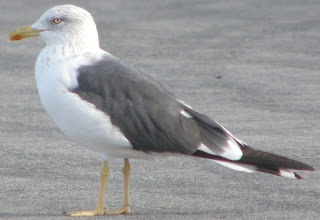
The star of the day was this Baltic Gull, (a male ringed as pullus in Finland in 1995) that came back again to winter here, for 3rd time:

The same bird with a presumed heuglini:

And again with a michahellis and 3 other adults of the fuscus complex, probably all three being intermedius, but what about the one on 1st winter plumage? :

Most probably a heuglini, pink legs, large size:

A nice looking michahellis:

And the most characteristic adult heuglini, a well known individual now!:

Two more of the fuscus complex, probably an intermedius on the back and a (female?) heuglini in front:

A Larus cacchinnans and a presumed intermedius:

Another "fuscus type" with 3 young birds, all probably from the same problematic taxon:

Two different birds in 2nd winter plumage, probably one intermedius, one fuscus:


What about this one? a western type LBBG or a Baltic? something else? any suggestion? :

Michahellis 1st winter:

And michahellis on 2nd winter plumage:

-------------------------------------------------------------------------------
I also give some picture of difficult cases, pictures taken on Nov 6.
A small-sized and short-billed Gull, a possible Larus armenicus:

An interesting young bird, probable michahellis, see bill:

A sub-adult Caspian?:

And another small-sized bird with a grey mantle lighter for being a heuglini or a graelssii, rosy legs, see it with a 1st winter michahellis:

And alone:








































